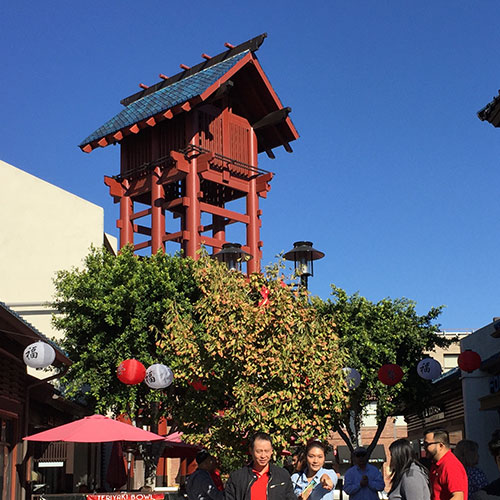Exploring Little Tokyo's evolution through eateries
Although Little Tokyo only takes up 67 square acres in Downtown, a quick culinary tour through the neighborhood can showcase its mixture of modern LA flair and traditional Japanese cuisine.
Little Tokyo’s history dates all the way back to 1886, when former Japanese sailor Hamanosuke "Charles Hama" Shigeta settled in the area just east of downtown Los Angeles. Setting an early tone for the neighborhood’s future, Shigeta decided to open the Kame Restaurant on East First Street. The first Japanese owned business in the area was a restaurant, which is extremely fitting for a neighborhood that now prides itself on its long-standing culinary prowess.
In the 131-year gap between now and when Kame Restaurant was established, Little Tokyo has seen its fair share of transformations. The Exclusion Act of 1924 impeded Japanese migration to America, while internment camps tore at the fabrics of the community during World War II. However, now many see Little Tokyo as a neighborhood that is on the rise, along with the rest of downtown LA. While the changing character has recently spurred a residential boom that has made the area more desirable to those outside the Japanese community, it has come at the cost of higher rent. As a consequence, Little Tokyo is slowly losing a piece of its traditional Japanese identity. This is especially true for the district’s food scene.
“The restaurant scene in Little Tokyo is interesting because it still has many old, family-owned businesses, but it's becoming trendier and less Japanese over time,” explains Mia Nakaji Monnier, a writer for Little Tokyo’s Rafu Shimpo newspaper. “Part of the reason for the change in ownership is that Japanese Americans don't really live in Little Tokyo anymore.”
Raised prices brought on by the changing demographics have affected Japanese eateries with more traditional vibes such as Oiwake, which permanently shut its doors this September after being open 26 years in the Japanese Village Plaza. Now places like Spitz that offer “Mediterranean street food” or chains such as Starbucks and Subway are becoming more common in Little Tokyo to keep up with the shift. These new faces are causing a dilemma with restaurants similar to Oiwake. Is it best to adapt and appease the changing crowds or follow the familiar Japanese heritage?
JiST Café on Judge John Aiso Street does its best to stay true to Little Tokyo’s roots and still appeal to the neighborhood’s increasingly non-Japanese and younger residents. Chef Glen Ishii decided to incorporate characteristics of his own family’s cooking lineage into JiST Café.
“Back then it was more Japanese traditional home comfort food,” Ishii recalled. “But as you see what's surrounding Little Tokyo, as far as the people that are coming in, the apartments and condominiums and so on, I don't know if that was a good idea for me to do that.”
JiST is representative of Little Tokyo’s community that was built on family owned restaurants. Ishii’s family has been in the restaurant business since before World War II when his grandmother opened the original location. His parents took over the same restaurant in the 70’s and ran it for the next couple of decades until briefly shutting down before being reopened by his uncle in its current address. Even through all of the turnover, Ishii and his professional partner Caroline Glen opened JiST Café three years ago with intentions of keeping the chef’s family recipes intact.
“The most popular dish here is the chashu hash and eggs,” says Ishii. “For the chashu hash, my grandmother started the recipe with barbecue pork and dumplings and that's what they were known for. They fed quite a bit of Japanese Americans, a lot of generations.”
As for the menu, JiST is solely geared towards breakfast and lunch. This focus on serving food earlier in the day is a sharp contrast from most of JiST’s competition in Little Tokyo that puts more emphasis on the dinner crowd. Some of the choices include chocolate chip and banana pancakes, breakfast burritos, chop salads and a katsu sandwich.
Ishii opened his restaurant with the knowledge of Little Tokyo’s changing culture. He decided to embrace the diverse customer base and offer a style that would entice the masses across all backgrounds.
“It's a mix, but more of the younger generation is what we're trying to cater to and the ones that are coming in here,” Ishii notes. “So we're welcoming to everybody, but like I said, Little Tokyo is trending in different ways. Other than the Japanese Americans, other ethnicities are coming into Little Tokyo as well.”
If the current trends in Little Tokyo stay strong, then the neighborhood will likely see even more of the big name franchises and other establishments that step away from the area’s Japanese beginnings. The evolving residential landscape will add diversity to what is an already wide array of dining options. More of the old school spots could face a fate similar to Oiwake with less Japanese families living in the area. Or Little Tokyo could gain inspiration from JiST to become a melting pot of Japanese-American cuisine to keep up with the times that are increasingly more complex, yet creative.


